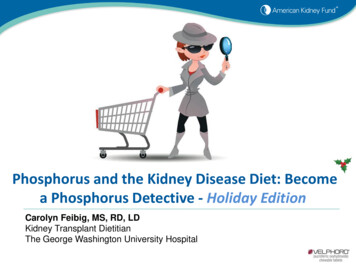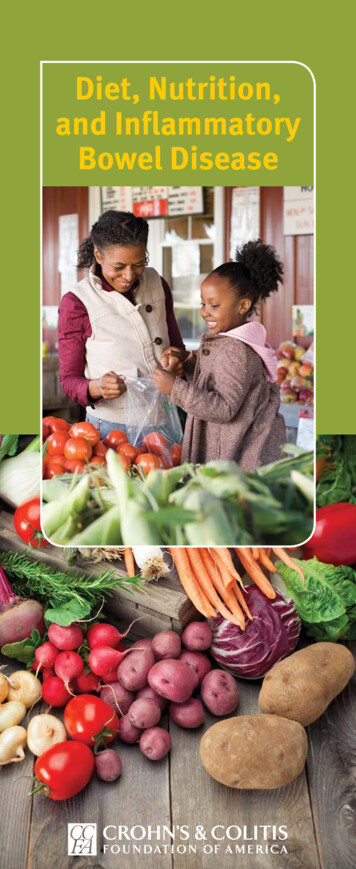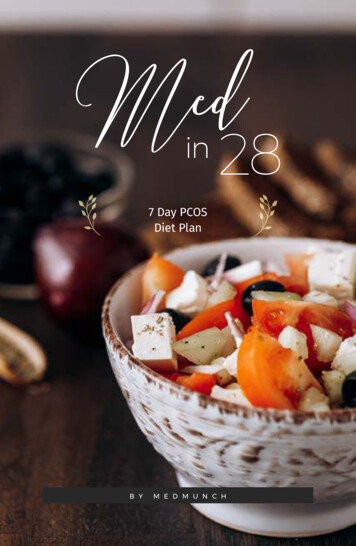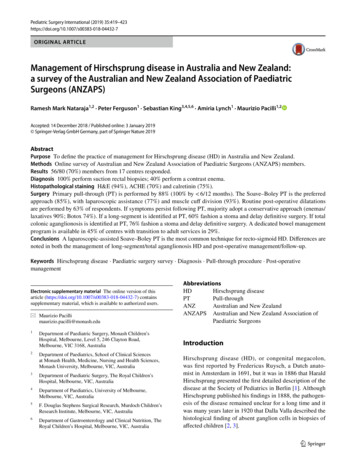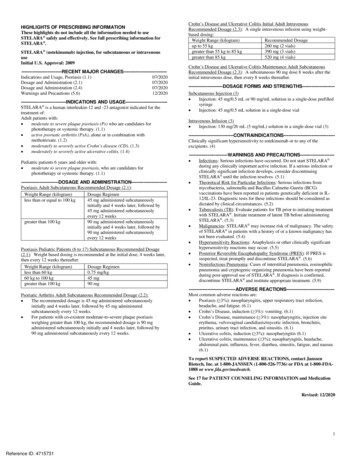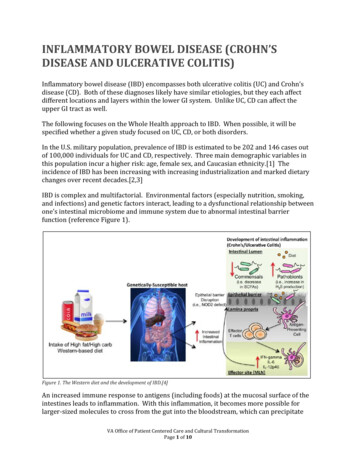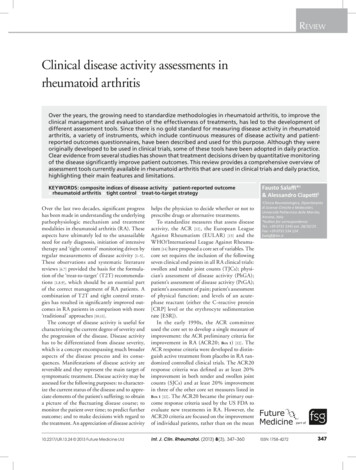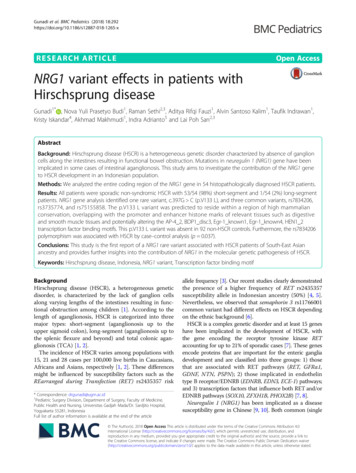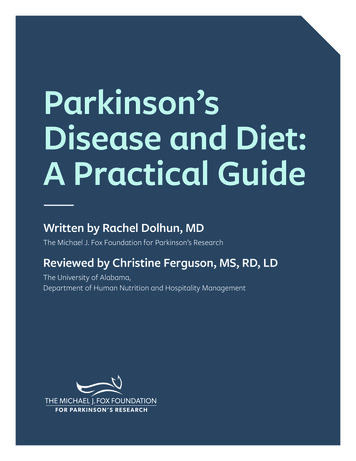
Transcription
Parkinson’sDisease and Diet:A Practical GuideWritten by Rachel Dolhun, MDThe Michael J. Fox Foundation for Parkinson’s ResearchReviewed by Christine Ferguson, MS, RD, LDThe University of Alabama,Department of Human Nutrition and Hospitality Management1
There is no one diet for Parkinson’s disease (PD). Butwhat you eat may affect how well your medicationworks and ease Parkinson’s non-movement symptoms,such as constipation or low blood pressure. For peoplewith PD, doctors recommend a balanced diet, with plentyof fruits and vegetables, which contain antioxidants.Antioxidants clear out free radicals, substances thatare harmful to cells.A nutritious diet also includes whole grains (whole wheat,quinoa, oats, brown rice), healthy fats (avocado, nuts,olive oil) and, for non-vegetarians, more fish and poultryinstead of red meat. This diet is heavier on whole,unprocessed, non-sugary foods. In the United States, youcan find these items on the perimeter of the grocerystore, in the fresh produce sections.The Michael J. FoxFox FoundationFoundation forfor Parkinson’sParkinson's ResearchResearchParkinson’sDiseaseA Practical GuideVisiting FamilyWho andHaveDiet:Parkinson’s2
Shopping list for antioxidant-containing foods Coffee and green tea Dark chocolate: 80 percent or higher cacoa Fruits: apples, bananas, berries, cherries, grapes, melons, oranges, peaches,pears, pomegranates Legumes: black beans, cannellini beans, chickpeas, kidney beans, lentils,peas, pinto beans Nuts and seeds: almonds, hazelnuts, pecans, pine nuts, walnuts, groundflax seeds, hydrated chia seeds, pumpkin seeds Red wine: in moderation (one 5-ounce glass per day or less), if approvedby your physician Soy: edamame, soybeans, tofu Vegetables: artichokes, asparagus, beets, bell peppers, broccoli, cabbage,carrots, cauliflower, garlic, kale, lettuce, mushrooms, okra, onion,potatoes, spinach, squash, tomatoesDiet and Parkinson’s MedicationsIf you take certain Parkinson’s drugs, dietary adjustments may help yourmedications work better or avoid side effects.Levodopa/CarbidopaDuopa, Inbrija, Parcopa, Rytary, Sinemet, Sinemet CR, StalevoLevodopa is absorbed in the same part of the gut as protein in food. Takinglevodopa at the same time as eating protein (meat, fish, cheese, beans or nuts)may mean less medication is absorbed. If levodopa doesn’t work as well as youwould like — it doesn’t kick in quickly or it wears off before the next dose isscheduled — consider separating it from meals. Swallow your pill, for example,30 to 60 minutes before or after you eat. (If this causes nausea, combine it witha low- or no-protein snack, such as crackers, dry toast or oatmeal.) Or, savehigher amounts of protein for dinner and eat more vegetables andcarbohydrates during the day when it’s important for medication to work well.(This is called the “protein redistribution” diet.)The Michael J. FoxFox FoundationFoundation forfor Parkinson’sParkinson's ResearchResearchParkinson’sDiseaseA Practical GuideVisiting FamilyWho andHaveDiet:Parkinson’s3
Dopamine agonistsMirapex (pramipexole), Neupro (rotigotine) and Requip (ropinirole)This class of drugs does not compete with dietary protein for absorption likelevodopa does, so there are no specific dietary restrictions. But each individualhas different medication responses and side effects. If symptoms are generallypoorly controlled, your doctor may recommend you take the drug on an emptystomach. If, on the other hand, the medication causes a side effect such as nausea,your doctor may suggest taking it with food.MAO-B inhibitorsAzilect (rasagiline), selegiline, Xadago (safinamide)These medications increase a substance called tyramine. When mixed with foodshigh in tyramine, the combination could significantly raise blood pressure. Peoplewho take these drugs should be aware of the potential for this rare but seriousinteraction. You don’t have to avoid tyramine-containing foods completely, buteat them in moderation.Foods high in tyramine: Alcohol: tap beer, wine, vermouth Aged cheese: blue cheese, Camembert, Swiss Cured, fermented or air-dried meat: mortadella, salami Fermented cabbage: kimchi, sauerkraut Pickled fish: herring, lox Soybean products: miso soup, soy sauce, tofuTreat diet like medication. Don’t makesignificant changes without firstdiscussing with your physician and,if you have one, registered dietitian.The Michael J. FoxFox FoundationFoundation forfor Parkinson’sParkinson's ResearchResearchParkinson’sDiseaseA Practical GuideVisiting FamilyWho andHaveDiet:Parkinson’s4
Diet and Parkinson’s SymptomsConstipationConstipation is, unfortunately, common for people with Parkinson’s disease. Notonly is this non-movement symptom uncomfortable, it can interfere with theuptake and benefit of medication. The first steps in managing constipation aredietary and lifestyle changes. Consider these tips: Drink at least six 8-ounce glasses of water per day.Water increases flow through the digestive tract. Warm water or prune juice,especially in the mornings, can help stimulate a bowel movement. Caffeine,alcohol and hot weather can cause dehydration and therefore increase yourwater needs. Add more fiber to your diet.Fiber helps drive waste through the intestine. Gradually increase the amountof fiber in your diet with vegetables, berries, fruits with skin (such as pearsand apples) and whole grains. As you increase your fiber intake, you mustalso increase your fluid intake. Fiber and fluid work together to normalizebowel movements. Eat smaller meals throughout the day.Some people notice multiple small meals (rather than fewer larger ones) helpconstipation as they allow more time for digestion. But because dietaryprotein can affect the absorption of levodopa, talk to your doctor about thebest timing and structure of meals in relation to your medication. Consider foods containing probiotics and prebiotics.Probiotics are bacteria that may keep your digestive system healthy bybalancing the “good” and “bad” bacteria. Prebiotics help supply the “good”gut bacteria with energy. Some doctors recommend adding these to your dietfor constipation. Exercise regularly.Abdominal muscle movement helps activate the gut. Steady, moderatelystrenuous exercise, such as walking, swimming or light weightlifting, mayease constipation.The Michael J. Fox Foundation for Parkinson’s ResearchParkinson’s Disease and Diet: A Practical Guide
If dietary and behavioral changes aren’t enough, your doctor may recommendover-the-counter or prescription therapies for constipation. Always talk withyour doctor before taking any non-prescription medications to be sure they aresafe. Also, ask whether any of your medications could contribute toconstipation. Many pain medications and some Parkinson’s drugs (such asArtane, or trihexyphenidyl) can cause constipation as a side effect.Shopping list for constipation-fighting foods: Dried fruits: apricots, dates, figs, prunes, raisins Fresh fruits: apples, pears, plums High-fiber products: berries, beans, bran, peas, whole grains Probiotic-containing foods: kefir, kombucha, miso, sauerkraut, tempeh, yogurt Prebiotic-containing foods: artichokes, asparagus, bananas, garlic, onions,soybeans, whole grainsLow Blood PressureIn Parkinson’s, low blood pressure can come from the disease and from some ofthe medications used to treat it. Low blood pressure can cause dizziness andlightheadedness and can increase walking trouble and risk for falls. As withconstipation, the initial treatments are dietary and lifestyle changes. A fewsuggestions: Drink at least six to eight 8-ounce glasses of water each day.Try filling a half gallon (or any measured jug) every morning so you can trackyour intake. Before standing from sitting, try drinking a full, cold glass ofwater as this can raise blood pressure for a short period. Add salt to your food or eat salty foods.Examples include V8 juice, Gatorade and canned soups. Ask your doctorabout the right amount of salt for you and whether your heart and kidneys arehealthy. Too much salt can stress these organs. Avoid hot or alcoholic beverages.These liquids may temporarily lower blood pressure.The Michael J. FoxFox FoundationFoundation forfor Parkinson’sParkinson's ResearchResearchParkinson’sDiseaseA Practical GuideVisiting FamilyWho andHaveDiet:Parkinson’s6
Eat multiple small meals throughout the day.For some people larger meals can lower blood pressure. Smaller meals mayeven out fluctuations. Exercise regularly.A regular exercise routine is good for general health and blood pressues, butavoid excessive sweating, which can worsen low blood pressure.Behavioral adjustments also are important: Change positions slowly.When moving from lying down to sitting and from sitting to standing, take afew seconds or even a minute to let dizziness pass. Avoid standing for long periods.Prolonged standing can lead to low blood pressure and passing out. If you’rein one spot for a long time, shift your weight between your feet. Raise the head of your bed or use more pillows.Increasing the incline of your head at night can improve blood pressure. Wear compression hose or an abdominal binder.These devices improve blood flow and increase blood pressure. You can buywhichever your doctor recommends from a medical supply store or onlineretailer. (Call your insurance company to see if they cover any or all costs.)These can be a bit uncomfortable and difficult to put on, but they aregenerally effective.The Michael J. FoxFox FoundationFoundation forfor Parkinson’sParkinson's ResearchResearchParkinson’sDiseaseA Practical GuideVisiting FamilyWho andHaveDiet:Parkinson’s7
Review your medications with your doctor to see if any are contributing to lowblood pressure. Sometimes the drug you once took to control high blood pressureis no longer necessary (or the dose or timing needs to be changed). Other drugs— certain antidepressants, fluid pills or bladder medications, for example — alsocan decrease blood pressure and may need adjustment.When diet, lifestyle and medication changes aren’t enough (you still havedizziness and lightheadedness, for example), your doctor may prescribemedication specifically to raise blood pressure.Swallowing ProblemsAs Parkinson’s progresses, a person may develop changes with eating or drinking.It may be more difficult to swallow certain foods or liquids, or you may noticeyou’re clearing your throat or coughing with meals. For some, it feels like foodgets stuck as it’s going down. Swallowing problems can be mild or moresignificant, and they could increase risk for choking or pneumonia. Your doctorand a speech and swallowing therapist can evaluate and treat swallowingproblems. Solutions for swallowing difficulties may include: Strategies to swallow safely such as tucking your chin while swallowing, notdrinking through straws, taking small bites and chewing slowly, and waitinguntil after meals to drink beverages. Diet changes such as thickening liquids or making foods softer. Exercises to strengthen swallowing muscles.A speech and swallowing therapist will offer tactics and tips tailored to you, yourdietary preferences and your specific swallowing problems. For example, atherapist might instruct you to avoid certain foods such as dry breads and cakes,rice, and nuts and seeds.Sometimes people have more severe swallowing problems and can’t eat enoughto maintain their weight or nutritional needs. Or they have repeated bouts ofpneumonia. In these cases, doctors may discuss a feeding tube. This is a lesscommon situation for people with Parkinson’s, and having swallowing problems(especially early or mild) does not mean you will later need a feeding tube.The Michael J. FoxFox FoundationFoundation forfor Parkinson’sParkinson's ResearchResearchParkinson’sDiseaseA Practical GuideVisiting FamilyWho andHaveDiet:Parkinson’s8
Parkinson’s medications may help swallowing problems somewhat, but theyrarely relieve them completely. It also may be harder to take your pills when youhave trouble swallowing, and you may want to ask your doctor about otheroptions. Levodopa, for example, comes as a capsule (Rytary) that can be openedand sprinkled on applesauce (or food of similar consistency), a tablet (Parcopa)that dissolves in the mouth and a gel (Duopa) that’s continuously infused directlyinto the small intestine.Many people anecdotally share thattheir symptoms improve when theyfollow a specific regimen.Specific Diets and Parkinson’sResearch has not proven any particular diet can slow Parkinson’s progression orease all symptoms. But diet is hard to study. It’s difficult to monitor and dictateexactly what and when people eat and it’s sometimes impossible to know whetherimprovement is from a behavioral change, new motivation or greater sense ofwell-being. In other words, a person may feel and do better because they aretaking an action, not because of the diet itself.Many people anecdotally share that their symptoms improve when they follow aspecific regimen. But Parkinson’s is different for every individual and peoplerespond differently to food, just as they respond differently to medications. Whatworks for one person may or may not work for another.If a certain diet works for your Parkinson’s, there may be no reason to stop. But ifyou are beginning to contemplate a new diet for Parkinson’s, discuss the pros andcons with your doctor. Think too about how challenging shopping, preparing andselecting meals may be and if the program may overly restrict the meals you canenjoy with family and friends. A registered dietitian can provide additionalThe Michael J. FoxFox FoundationFoundation forfor Parkinson’sParkinson's ResearchResearchParkinson’sDiseaseA Practical GuideVisiting FamilyWho andHaveDiet:Parkinson’s9
education and support if you decide to try a new diet. Ask your doctor fora referral or search online for one in your area. (The Academy of Nutritionand Dietetics maintains a database of registered dietitians at www.eatright.org/find-an-expert.) Be sure to ask the dietitian about their experience withParkinson’s.A few of the more popular diets:Gluten-free DietThis regimen cuts out foods that are made of gluten. Gluten is a protein inwheat, barley and rye, which are key ingredients in bread, pasta and cereal. Inpeople who have celiac disease, gluten sensitivity or a gluten allergy, eatinggluten can cause bloating, nausea and diarrhea. It also may cause headaches,joint pain, and mood and memory changes.Diets, like alltreatments, areindividualized.To find the best onefor you, consideryour medicalconditions, activitylevel and otherfactors that impacteating and lifestyle.Currently, there is no strong pre-clinical or clinical trial evidence to support theuse of a gluten-free diet for Parkinson’s disease. There is one report of a manwith PD and “silent celiac disease” (no symptoms but positive lab tests)showing significant improvement in Parkinson’s symptoms upon removinggluten from his diet.Some of the diet’s general benefits may come from its focus on naturallygluten-free products. These include fruits, vegetables, meats, eggs, nuts, seedsand other whole, unprocessed foods. (Processed gluten-free foods are usuallyhigher in sugar and calories.) Still, sticking to a strict gluten-free diet can bechallenging and put you at risk for certain vitamin deficiencies.Mediterranean DietThis “heart-healthy” approach stresses plant-based foods (fruits, vegetables,whole grains and legumes such as chickpeas, lentils and peas); fish and poultryover red meat; and healthy fats such as nuts and olive oil. Red wine inmoderation is optional. Researchers have linked the Mediterranean diet tolower levels of “bad” cholesterol as well as a decreased risk for Parkinson’s,Alzheimer’s, heart disease and certain cancers. Many doctors recommend thisdiet for possible positive effects on thinking and memory, although no directbenefits have yet been proven.The Michael J. FoxFox FoundationFoundation forfor Parkinson’sParkinson's ResearchResearchParkinson’sDiseaseA Practical GuideVisiting FamilyWho andHaveDiet:Parkinson’s10
In Parkinson’s, two studies have correlated the Mediterranean diet with lowerdisease risk and one showed that in people who do get Parkinson’s the dietmight delay time to diagnosis. Potential benefits could be from antioxidant oranti-inflammatory effects.MIND (Mediterranean-DASH Intervention forNeurodegenerative Delay) DietThis method combines concepts of the Mediterranean and DASH (DietaryApproaches to Stop Hypertension) diets. The MIND diet has been associatedwith lower rates of Parkinson’s and Alzheimer’s disease. It recommendsconsumption of 10 foods: Leafy greens: six or more servings per weekServing size: two cups raw or one cup cookedExamples: chard, collard greens, kale, lettuce, mixed greens, spinach Other vegetables: at least one serving per dayServing size: one cup raw or cookedExamples: beets, green or red bell peppers, broccoli, carrots, celery,corn, eggplant, lima beans, peas, potatoes, string beans, summer squash,tomatoes, zucchini Berries: two or more servings per weekServing sizes: one cup raw or ½ cup driedExamples: blackberries, blueberries, raspberries, strawberries Poultry: two servings per weekServing size: one ounce Fish: one serving per weekServing size: one ounce Beans: at least three servings per weekServing size: ¼ cupExamples: beans, peas and lentilsThe Michael J. FoxFox FoundationFoundation forfor Parkinson’sParkinson's ResearchResearchParkinson’sDiseaseA Practical GuideVisiting FamilyWho andHaveDiet:Parkinson’s11
Nuts: five servings per weekServing size: ½ ounceExamples: almonds, hazelnuts, pecans, pine nuts, walnuts Olive oil: use as main cooking oil Whole grains: three servings per weekServing sizes and examples: one slice of 100 percent whole grain bread; ½cup cooked oatmeal, rice or pasta; three cups popcorn; one cup whole graincereal; one 6-inch corn tortilla Red wine: up to one 5-ounce glass per dayThis diet recommends limiting the following: Butter and margarine: less than one tablespoon per day Cheese: less than one 1-ounce serving per week Red meat: less than four 1-ounce servings per week Fried food: less than one meal (serving not specified) per week Pastries and sweets: less than five servings per weekThe Michael J. FoxFox FoundationFoundation forfor Parkinson’sParkinson's ResearchResearchParkinson’sDiseaseA Practical GuideVisiting FamilyWho andHaveDiet:Parkinson’s12
Ketogenic DietThere is no single“Parkinson’s diet.”The best diet forParkinson’s andgeneral well-beingis a healthy,balanced regimenfocused on whole,unprocessed foods.This plan is high in fat, low in carbohydrates and moderate in protein. Its aimis to shift the body’s usual energy source from sugar (glucose) to fats, or ketonebodies, which some believe are a more “efficient” fuel. Doctors sometimesrecommend the ketogenic diet for severe seizures (epilepsy) uncontrolled bymedication. In Parkinson’s, researchers suggest the diet could work byproviding different energy for mitochondria (the cell’s power source). In PD,potential support for the ketogenic diet comes from pre-clinical work and ahandful of clinical trials. In one study, five people with Parkinson’s followed theketogenic diet for 28 days and demonstrated improvement in their movementsymptoms and ability to perform daily activities. Another study randomlyassigned 47 people to either the ketogenic or a low-fat diet for eight weeks.While both groups showed movement and non-movement symptomimprovement, the ketogenic dieters had greater non-movement symptomimprovement. Because both of these studies were short, the long-term benefitsand harms are unknown at this time.Because this diet has lower protein, which can interfere with levodopa’sabsorption and effectiveness, some of its potential benefit could be due toimproved medication absorption rather than a direct effect on the brain. Onthe other hand, adequate protein intake is important for maintaining yourmuscles, exercising and doing your daily activities.This diet also is typically low in fruits and vegetables that provide essentialnutrients such as vitamins, minerals, antioxidants and fiber. Following theketogenic diet could lead to decreased appetite, constipation, and nauseaor vomiting.If, after considering the possible side effects and benefits, you decide to go onthis strict diet, work with your doctor and dietitian to get started. You’ll likelyhave regular bloodwork and monitoring for side effects such as dehydration,low glucose, kidney stones and certain nutritional deficiencies.Modified forms of the ketogenic diet include the Atkins and Grain Brainregimens. Both emphasize higher fat and lower carbohydrate consumption butthey differ in the types of fats recommended.The Michael J. FoxFox FoundationFoundation forfor Parkinson’sParkinson's ResearchResearchParkinson’sDiseaseA Practical GuideVisiting FamilyWho andHaveDiet:Parkinson’s13
Frequently Asked Questionsabout Parkinson’s and DietI’ve heard fava beans contain levodopa. Should I eat them to treatmy Parkinson’s?Fava beans do contain levodopa. But how much they contain and how well yourbody might absorb them varies. If and how your symptoms might respond tofava beans is unclear. Eating fava beans on their own to treat your Parkinson’smay or may not have any noticeable effect. Consuming large amounts of fava beanswhen you are taking prescribed levodopa (in Sinemet or Rytary, for example) couldresult in too much levodopa and dyskinesia (uncontrolled, involuntary movement).What about mucuna pruriens? Can I take that for my Parkinson’s?Mucuna pruriens, or “velvet bean,” is another dietary source of levodopa. Oneimportant way it differs from prescription levodopa (such as Sinemet or Rytary)is that it’s not combined with carbidopa, the drug that prevents levodopa’sbreakdown before it gets to the brain, where it turns to dopamine. This maymean you need higher doses of mucuna to get the same amount of levodopa tothe brain.It also can be difficult to figure out the correct dose and to know exactly howmuch you’re taking. Because the U.S. Food and Drug Administration (FDA) doesnot regulate dietary supplements such as mucuna like a drug, your actual dosecould be different from what the bottle says. And the supplement could containimpurities or other chemicals.Taking this form of levodopa could result in uneven symptom control (good somedays, not so good others) and, if added to prescription levodopa, too muchlevodopa and dyskinesia.What supplements should I take for Parkinson’s?Doctors do not typically recommend any dietary supplements to treat Parkinson’sdisease or its symptoms due to the lack of conclusive research evidence. If,however, you have falls or are older, your doctor will want to make sure calciumThe Michael J. FoxFox FoundationFoundation forfor Parkinson’sParkinson's ResearchResearchParkinson’sDiseaseA Practical GuideVisiting FamilyWho andHaveDiet:Parkinson’s14
and vitamin D are at the right levels to boost bone health. And if you havea deficiency of a particular vitamin, you may want a daily replacement.Several supplements, including creatine, CoQ10, inosine and vitamin Eunfortunately have failed to slow Parkinson’s progression in Phase III clinicaltrials. A Phase II study of glutathione, an antioxidant, improved symptoms inboth the glutathione and placebo groups, so its true benefit is unclear.More researchis necessary.To understand howdiet affectsParkinson’s (andvice versa) and howwhat you eat couldease symptomsand potentiallyslow diseaseprogression, wemust continueadditional work.Supplements are available without a prescription, but always talk with yourdoctor about the potential positives and negatives before adding them to yourtreatment regimen. Most are affordable, but some (such as glutathione infusions)can cost thousands of dollars. And supplements, like all medications, can haveside effects and drug interactions. Simply because they are “natural” does notmean they are completely “safe.” Some may even affect your Parkinson’smedications and may need to, at the very least, be taken separately. Ironsupplements, for example, can interfere with levodopa absorption, so talk to yourdoctor and pharmacist about potential interactions and how best to take yourmedications and supplements. It is always recommended to try to meet yourvitamin and mineral needs through diet before taking supplements.Can coconut oil treat Parkinson’s disease?Coconut oil contains high amounts of fats called medium-chain triglycerides(MCTs). The body uses these fats for energy quickly and efficiently, so somebelieve MCTs have many potential health benefits and could improve brainfunction. Some people with Parkinson’s have reported anecdotal benefit withcoconut oil on both movement and non-movement symptoms, includingconstipation as well as thinking and memory. Currently, there is no validatedscientific research to support the use of coconut oil in Parkinson’s. In people withAlzheimer’s, a few small, short studies have shown improved learning, memoryand brain processing with MCTs. If you are considering MCTs or coconut oil,which are high in saturated fats, it’s typically recommended that you use them asa replacement for, not in addition to, other saturated fats such as butter. Talkwith your doctor about how coconut oil might fit into your daily regimen.The Michael J. FoxFox FoundationFoundation forfor Parkinson’sParkinson's ResearchResearchParkinson’sDiseaseA Practical GuideVisiting FamilyWho andHaveDiet:Parkinson’s15
Is drinking coffee good for Parkinson’s?In large population studies, researchers found that people who drank coffeeseemed to have a lower risk of being diagnosed with Parkinson’s. This shows arelationship between coffee and Parkinson’s, but does not prove that drinkingcoffee decreases the risk of Parkinson’s. Researchers can follow these associationsto learn more about the disease and develop potential treatments. A therapy inclinical testing for dyskinesia (involuntary, uncontrolled movement), forexample, works in the same brain areas as caffeine.One study of people with Parkinson’s who drank coffee to ease symptomsshowed no effect on tremor or other movement problems. (And in some people,high amounts of caffeine may even temporarily worsen tremor.)At the current time, there’s no significant support for coffee or caffeine as atreatment to slow Parkinson’s or treat its symptoms. But because coffee andgreen tea contain antioxidants, a daily cup may be good for general health.How is the gut connected to Parkinson’s?Much evidence links the gut, or digestive tract, to Parkinson’s. For many peoplewith PD, non-movement symptoms are tied to this body system. Constipationcan occur years or even decades before diagnosis. As disease progresses, thestomach can empty slowly or irregularly causing symptoms (bloating or nausea,for example) and impacting medication benefit.The Michael J. FoxFox FoundationFoundation forfor Parkinson’sParkinson's ResearchResearchParkinson’sDiseaseA Practical GuideVisiting FamilyWho andHaveDiet:Parkinson’s16
Early research also shows that gut bacteria (the microbiome) differs betweenpeople with and without Parkinson’s and even among people with Parkinson’swho have different symptoms (more tremor as opposed to more walking andbalance problems, for example). Work now is evaluating whether this is a causeor result of Parkinson’s or its treatment (or some other factor, such as diet).Alpha-synuclein, the sticky protein that clumps in the brains of most people withParkinson’s, is seen in the gut of people with Parkinson’s, too. This leads many tobelieve that disease could start in the gut and travel to the brain. If true, thiscould be an optimal place for early diagnosis and intervention.NOTE: The medical information contained in this article is for general information purposes only. The Michael J.Fox Foundation for Parkinson’s Research has a policy of refraining from advocating, endorsing or promoting anydrug therapy, course of treatment, or specific company or institution. It is crucial that care and treatment decisionsrelated to Parkinson’s disease and any other medical condition be made in consultation with a physician or otherqualified medical professional.The Michael J. FoxFox FoundationFoundation forfor Parkinson’sParkinson's ResearchResearchParkinson’sDiseaseA Practical GuideVisiting FamilyWho andHaveDiet:Parkinson’s17
A nutritious diet also includes whole grains (whole wheat, quinoa, oats, brown rice), healthy fats (avocado, nuts, olive oil) and, for non-vegetarians, more fish and poultry instead of red meat. This diet is heavier on whole, unprocessed, non-sugary foods. In the United States, you can find these items on the perimeter of the grocery
